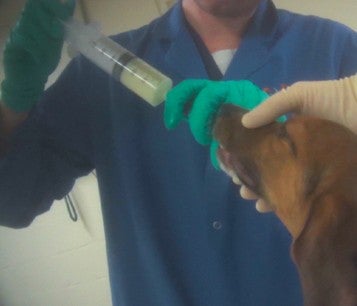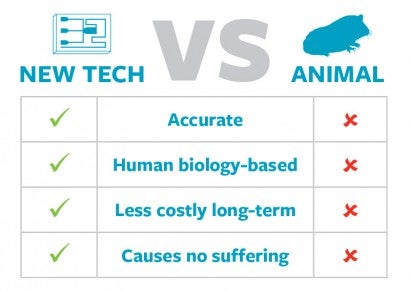Millions of dogs, monkeys, mice and other animals currently suffer in U.S. laboratories. But non-animal alternatives will one day completely replace experiments on animals. This will be a game-changer not just for animals, but for human health.
In contrast to animal experiments, non-animal alternatives employ cutting-edge methods that use human cells or are based on human data to more accurately and effectively predict how the human body will respond to drugs, chemicals and treatments.
Some of these modern approaches even use a patient’s own cells to test treatments or develop drugs based on a person’s unique genetic makeup, an approach known as personalized medicine. Unlike animal experiments, these methods represent the very latest techniques that science has to offer, provide countless possibilities to improve our understanding and treatment of the human body, and will only continue to improve over time. These non-animal methods are also typically faster and often less expensive than animal tests.
Stand with us to demand that the federal government, state governments, companies and universities stop relying on outdated animal experiments.

What alternatives are there to testing on animals?
Here are just some of the human health conditions currently benefitting from advanced non-animal technologies, with no animals harmed in the process:
Cancer: A lung organ-on-a-chip—a tiny 3D chip created from human cells that looks and functions like a miniature human organ—showed that the fluid buildup in the lungs caused by a drug frequently used by cancer patients was triggered by a patient’s lungs expanding and contracting, a finding that would not have been possible in animal experiments because researchers can’t stop and restart an animal’s lungs. The organ-on-a-chip was then used to test for drugs that would reduce the fluid buildup.
Cystic fibrosis: Organoids—3D replicas of human organs were created from the intestinal cells of a person with cystic fibrosis and were then used to test various drugs to determine which drug would be most effective in that person.
Chronic inflammatory demyelinating polyneuropathy (CIDP): A nervous system organ-on-a-chip using human cells and blood samples was created to show that muscle weakness in people with CIDP—a rare autoimmune condition—was caused by a component in the blood causing nerve damage. The results allowed scientists to get approval for a human clinical trial for a drug to treat the condition in people with CIDP. Rare conditions like CIDP can’t be studied using animal experiments because scientists aren’t able to recreate these diseases in animals, but the development of organs-on-chip models using cells from patients will help scientists to understand the cause and progression of these diseases and test possible treatments.
Skin allergies: A series of non-animal tests examining how human cells react to chemicals and how those chemicals interact with other substances is being used to determine if ingredients in everyday products such as laundry detergent, body lotion and drain cleaner will trigger an allergic reaction in human skin. These non-animal approaches have been proven to be more accurate than the outdated tests on guinea pigs and mice that are still used.
Zika virus: Brain organoids created with human cells proved that the Zika virus was causing microcephaly (small head size) in babies born to mothers who were infected with the virus. This discovery would not have been possible in animal experiments due to differences in animal and human brain structure. Scientists then used human brain organoids to test drugs that could be used to prevent or reduce the damage caused by microcephaly.
Heart arrythmias: Computer models using recordings from human heart activity are being used to test the adverse effects of potential drugs. Many drugs that are successfully tested in animals fail in human clinical trials because of dangerous effects on the human heart. This approach allows researchers to screen out potentially dangerous drug compounds before they are tested in humans—without using animals.
Autism spectrum disorder (ASD): Scientists are using non-embryonic stem cells from the discarded baby teeth of children with ASD to create nerve cells, which are then used to study how the brains of children with ASD are different.
